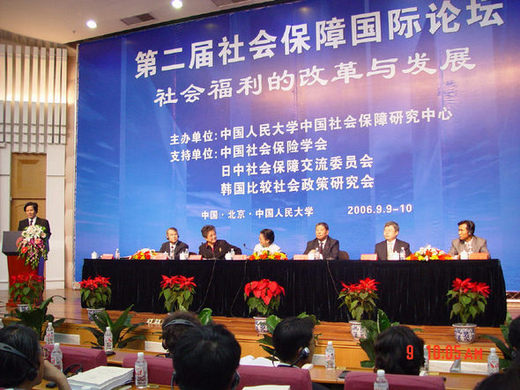 |
Aging population, wealth polarity among major issues faced
The winds of social welfare reform are blowing in South Korea, China, and Japan. The three nations are facing socioeconomic challenges such as wealth polarization and an aging populace, all amid a strong wave of neoliberalism in the political realm. A recent international conference held in Beijing on the subject of social welfare showed the current reality and the social policy direction of the three East Asian neighbors. Traps of development: aging and polarization Dou Yupei, China’s vice minister of civil affairs, said in the forum that "in China, the number of those over 60 stands at some 132 million (those over 65 total about 100 million), accounting for 11 percent of the total population." Zheng Gong Cheng, professor at the People’s University of China expected the Chinese population over 60 to pass 250 million people in 2020. This year, Japan entered an era of an "aged society," with its population over 65 surpassing 20 percent of its total population. In 2035, the rate will be 31 percent, with nearly one out of three people over 65.Currently, South Koreans over 65 make up as much as 9.3 percent of the total population, but the rate will rise to 20 percent in 2026. The rising gap between haves and have-nots is another task awaiting welfare reformists in Northeast Asian nations. A professor at a Chinese university said in the forum that the income gap in China "is widening, as the number of those in poverty is increasing." The professor noted that economic globalization is prompting the gap to widen as more and more laborers are losing their jobs through forced early retirement or job losses. In fact, a report by the U.S.-based Boston Consulting Group showed that about 0.5 percent of China’s wealthiest people accounted for 60 percent of the mainland’s wealth. The Gini coefficient of China is estimated at 0.47, with a Gini coefficient of 1.00 meaning absolute inequality. Japan, too, is also struggling with a growing income gap. The rate of poverty in Japan jumped to 15.3 percent in 2005, compared with 8 percent in 1995. The Gini coefficient of ordinary income in Japan rose to 0.498 in 2002, compared with 0.433 in 1990. Tokyo University professor Tagegawa Shogo said, "Japan’s worry is that the gap will continue to increase." Eye of the storm: welfare reform During the conference, a senior Chinese government official said, "Social welfare reform is quintessential for 130 million elderly, 60 million disabled, 600 million women and 300 million children...It is important for all people to share in the achievements of economic development." From this point of view, China is putting its focus on guaranteeing basic livelihood and services for elderly, disabled, and juveniles who have no ability to work, no government aid, and no income. However, the initiative is still a long way to go, as only some 130 million out of 700 million economically active Chinese have agreed to pay into the system. While Japan has established the most advanced social insurance and safety net among the three nations, it is carrying out social welfare reform under the perspective of neoliberalism by cutting pensions and raising health insurance costs in the face of its low birth rate and aging populace. Professor Takekawa said, "Because of the measures, inequality is rising as the Gini coefficient [has approached a high level]. In spite of the phenomenon, the government isn’t seen paying more attention to the inequality." South Korea, which is facing a triple threat from an aging population, wealth polarization, and a low birth rate, has introduced bold initiatives for social welfare reform since last year. However, Seoul National University professor Ahn Sang-hoon said in a speech this year that, "Still, the ratio of spending for public society to gross domestic product is 6.1 percent, the lowest among the Organization for Economic Cooperation and Development [OECD] members." This figure was 8.6 percent in 2005. Professor Ahn said that the concept of a welfare state needs to be passed on to the South Korean public. ChungAng University professor Kim Yeon-myeong said, "Social policy directions taken by South Korea, China, and Japan over economic polarization and aging populations will be indices of the future of these countries."





